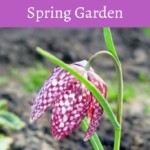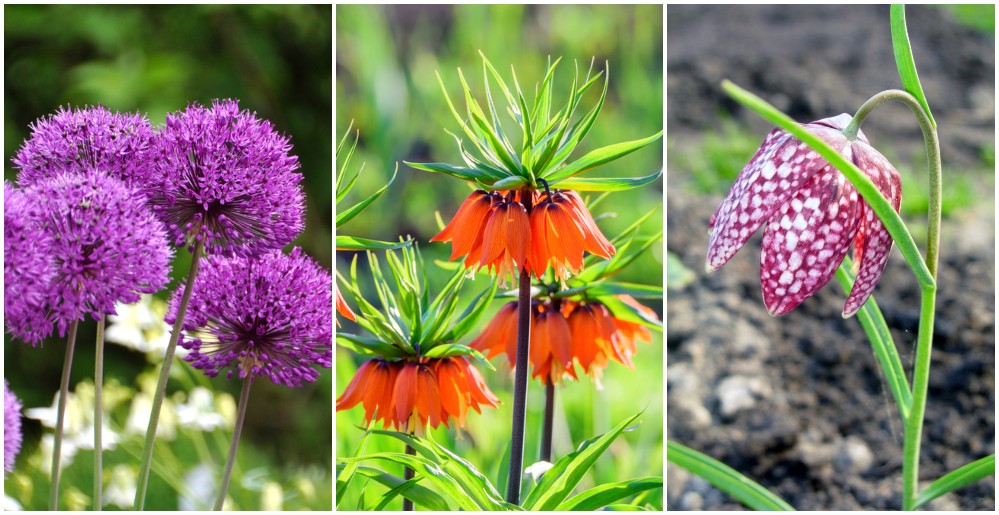
Flowering bulbs (and corms and tubers) are early harbingers of spring, providing some much needed color and beauty after a long and dreary winter season.
Aside from buoying our spirits, bulbs that emerge in late winter and early spring are an important source of nectar for bumblebees and other pollinators just waking up from a long nap.
Returning year after year, most spring blooming bulbs require a chilling period of 12 to 16 weeks in temperatures below 40°F. This is why they are planted in autumn when temperatures are cool but before the ground freezes.
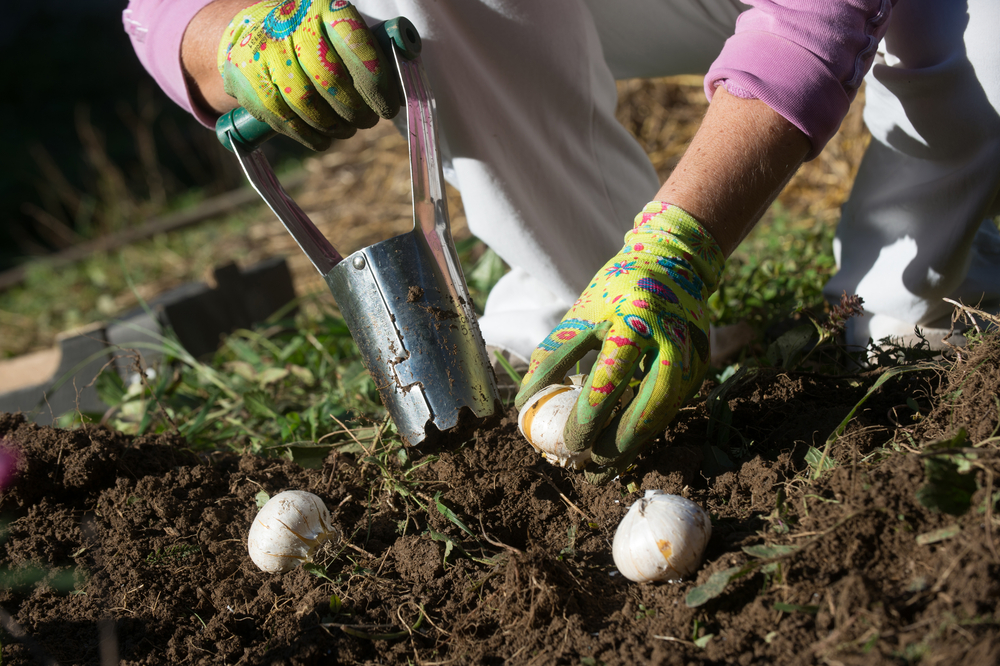
Get the timing right and you’ll have a wonderful cascade of blooms to carry you into summer.
15 Spring Blooming Bulbs
1. Snowdrop (Galanthus spp.)

Earning its name in both form and habit, snowdrop is one of the earliest bloomers, making its appearance in late February to March.
Snowdrop will even pop up when there is still a cover of snow on the ground.
It also resembles little drops of snow, with downward facing, bell shaped flowers in milky white.
Bloom time: February
Hardiness zone: 3 to 7
Sunlight exposure: Full sun to part shade
Planting depth: Plant bulbs 3 inches deep
Spacing: Plant in groups of at least 25 bulbs, spaced 2 to 3 inches apart
2. Glory of the Snow (Chionodoxa spp.)
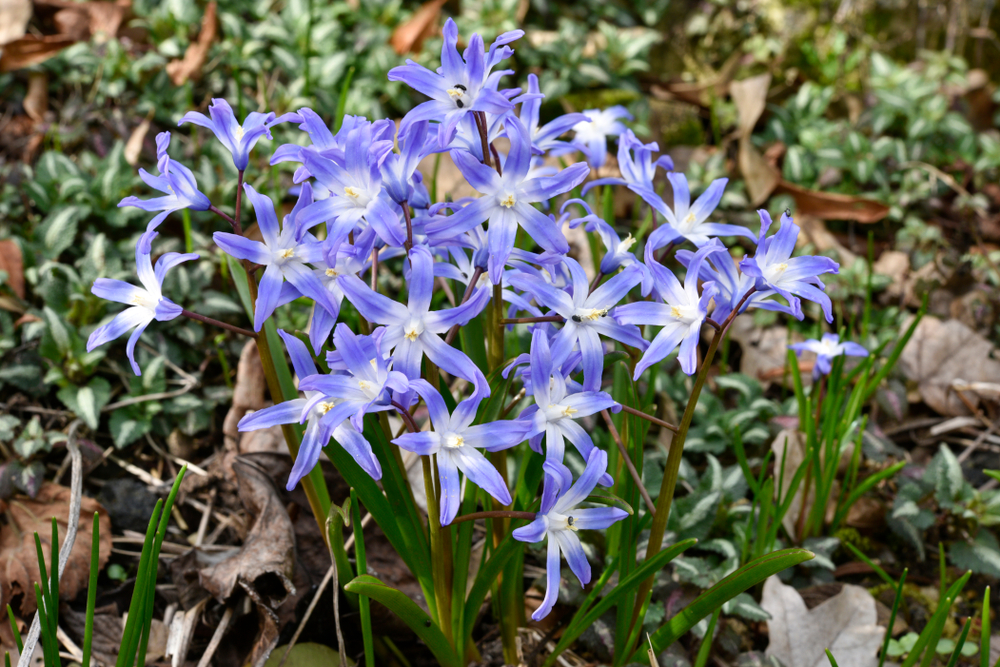
Glory of the snow is another really early bloomer that graces the landscape from February to April. It, too, will bear flowers in snowy conditions.
While there are pink and white blooming cultivars, the most common garden variety bears violet to lilac blue star-shaped flowers with a white center.
Glory of the snow self-seeds and produces bulb offsets each successive season, rendering drab winter scenes into gorgeous spreading carpets of blue.
Bloom time: February
Hardiness zone: 3 to 8
Sunlight exposure: Full sun to part shade
Planting depth: Plant bulbs 4 inches deep
Spacing: Plant in groups of at least 15 bulbs, spaced 2 inches apart
3. Snow Crocus (Crocus chrysanthus)
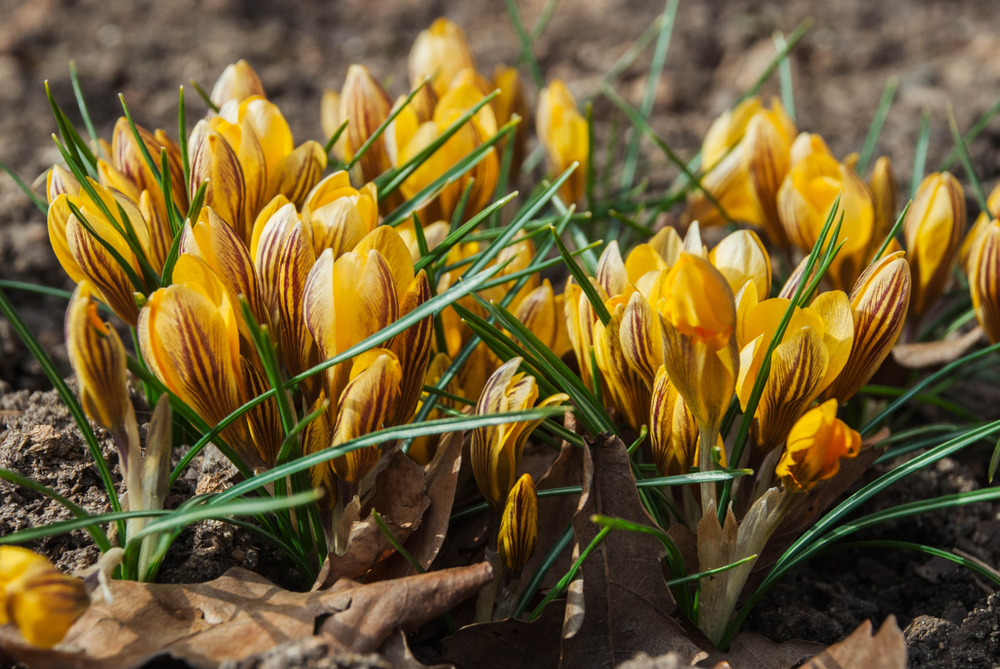
With more than 100 species within its genus, there are crocus varieties that bloom in winter, spring, and autumn.
Snow crocuses send out flowers from underground corms in late winter and early spring, and are hardy enough to poke through snowy drifts.
Although snow crocus is traditionally a cheery yellow hue, numerous cultivars offer more choice in the color palette, with pure white, cream, and bicolor options.
Bloom time: February
Hardiness zone: 3 to 8
Sunlight exposure: Full sun to part shade
Planting depth: Plant corms 3 inches deep
Spacing: Plant in large groups, spaced 3 to 4 inches apart
4. Winter Aconite (Eranthis hyemalis)
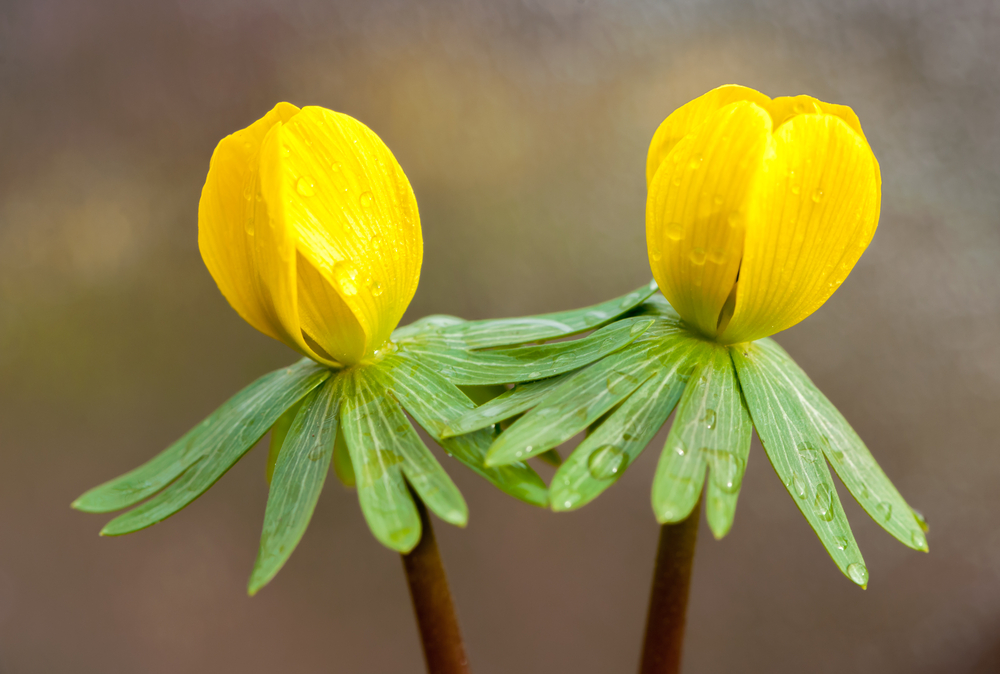
Winter aconite is a flowering tuber from the buttercup family. As another early riser, it supplies a much needed bright pop of yellow color from March to April.
An adorable specimen, winter aconite is pint sized (growing just 4 inches tall) with upward facing, cup shaped flowers that are surrounded by a collar of leafy bracts.
Soak winter aconite tubers overnight before planting. Once in the ground, leave them undisturbed for the best blooms.
Bloom time: March
Hardiness zone: 3 to 7
Sunlight exposure: Full sun to part shade
Planting depth: Plant tubers 3 inches deep
Spacing: Plant in large groups, spaced 2 to 3 inches apart
5. Daffodil (Narcissus spp.)
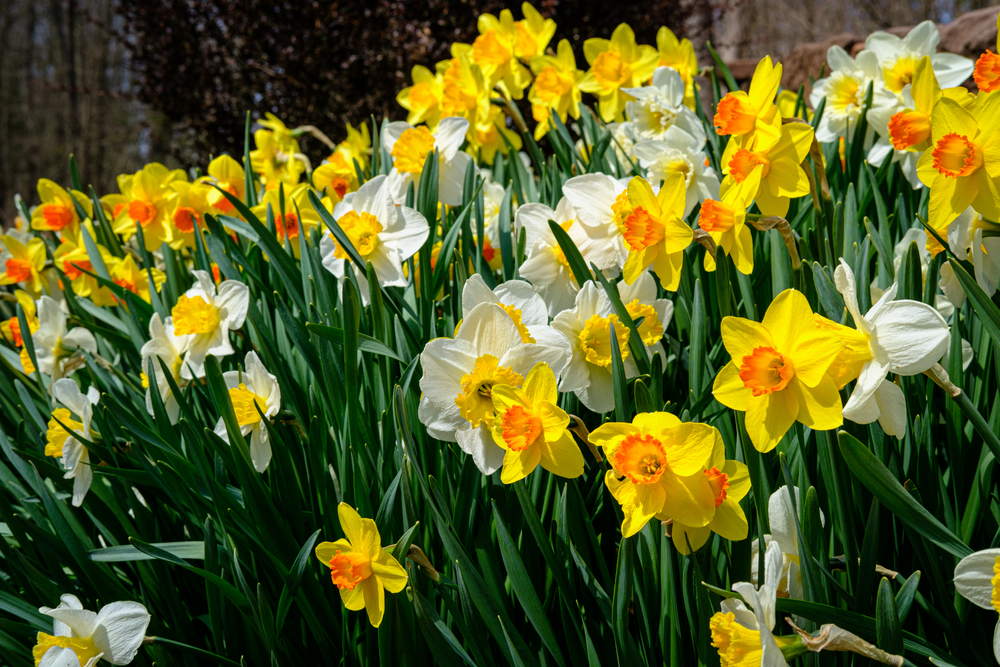
A classic choice for the spring garden, daffodils are a hardy and reliable early bloomer that return year after year.
Although daffodils are most often seen in yellow or white, they are available in dozens of cultivars that span oranges, pinks, and bicolor hues.
Depending on the species, they may flower singly or in clusters along the stem. All types share the same characteristic of a trumpet like corona surrounded by six petals.
Bloom time: March
Hardiness zone: 4 to 8
Sunlight exposure: Full sun to part shade
Planting depth: Plant bulbs 3 to 6 inches deep
Spacing: Space plants 4 to 8 inches apart
6. Reticulated Iris (Iris reticulata)
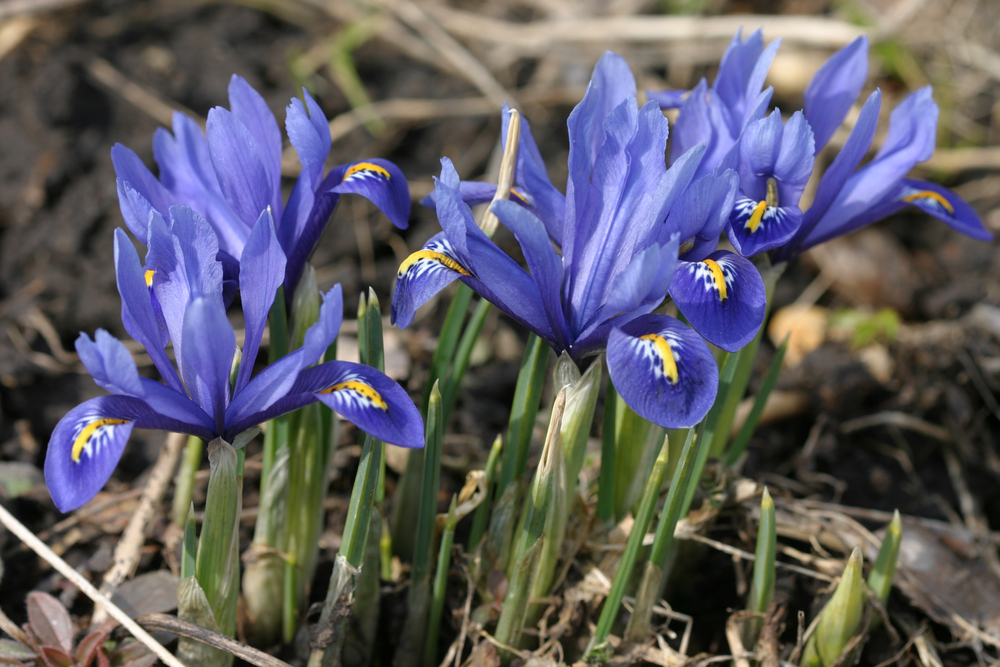
Reticulated iris is not only beautiful but supplies a delightful sweet fragrance early in the season.
With bluish to deep purple coloring, the outermost petals are marked with interesting gold and white streaks.
This low growing bulbous perennial produces bulblets and offsets after flowering. Dig up and divide bulblets in early autumn to grow the colony.
Bloom time: March
Hardiness zone: 5 to 9
Sunlight exposure: Full sun to part shade
Planting depth: Plant bulbs 4 inches deep
Spacing: Space plants 3 to 4 inches apart
7. Spring Crocus (Crocus vernus)
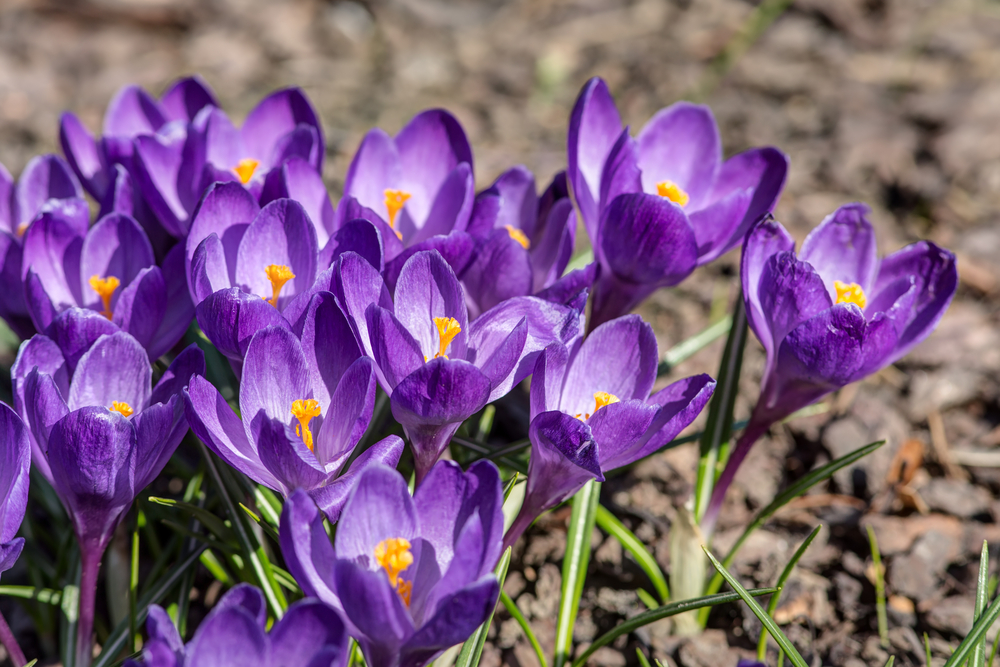
Spring crocus – also known as Dutch crocus and giant crocus – bears the largest flowers within the crocus family.
Setting its blooms about two weeks after snow crocus, spring crocus is frequently seen in white or purple hues. It opens up its cup-shaped flowers in bright sunlight and closes them each day at dusk.
With a 3 week flowering period, spring crocus looks absolutely stunning when planted in groups of 100 to 150.
Bloom time: April
Hardiness zone: 3 to 8
Sunlight exposure: Full sun to part shade
Planting depth: Plant corms 3 inches deep
Spacing: Space plants 3 to 4 inches apart
8. Tulip (Tulipa spp.)
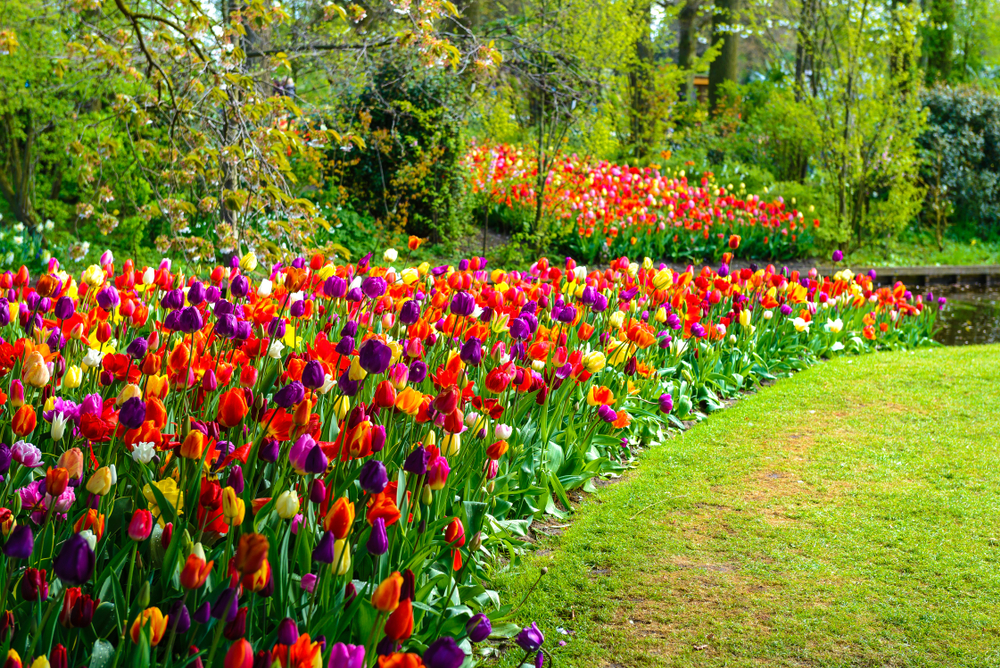
The large and showy flowers of tulips are a welcome sight in spring!
With about 75 species to choose from, tulips are organized into 15 divisions based on bloom times and flower shape. Though they are most often cup-shaped, some varieties feature fringed, oval, or pointed petals.
Tulips are typically in bloom from April to May and come in every color except true blue.
Although tulips are technically perennials, hybrid varieties don’t reliably return each year. Treat them as annuals or choose species tulips for a better rate of return.
Bloom time: April
Hardiness zone: 3 to 8
Sunlight exposure: Full sun
Planting depth: Plant bulbs 4 to 6 inches deep
Spacing: Space plants 2 to 5 inches apart
9. Siberian Squill (Scilla siberica)
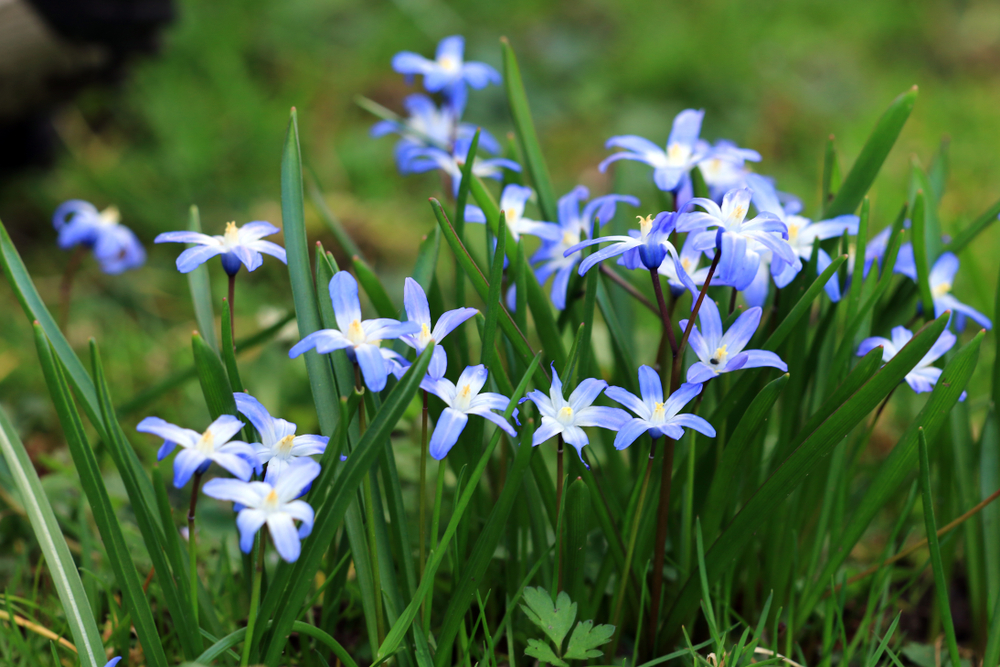
Siberian squill is an easy to grow, incredibly cold hardy bulbous perennial that provides a bright blue color to the early spring garden.
It bears multiple, nodding, bell-shaped blooms along each stem. Though it usually sticks with its cup shape, the petals will open up to a starry form in bright sunlight.
Multiplying its numbers each year through self-seeding and bulb offshoots, Siberian squill will over time create beautiful vast drifts.
Bloom time: April
Hardiness zone: 2 to 8
Sunlight exposure: Full sun to part shade
Planting depth: Plant bulbs 3 inches deep
Spacing: Space plants 2 inches apart
10. Windflower (Anemone blanda)
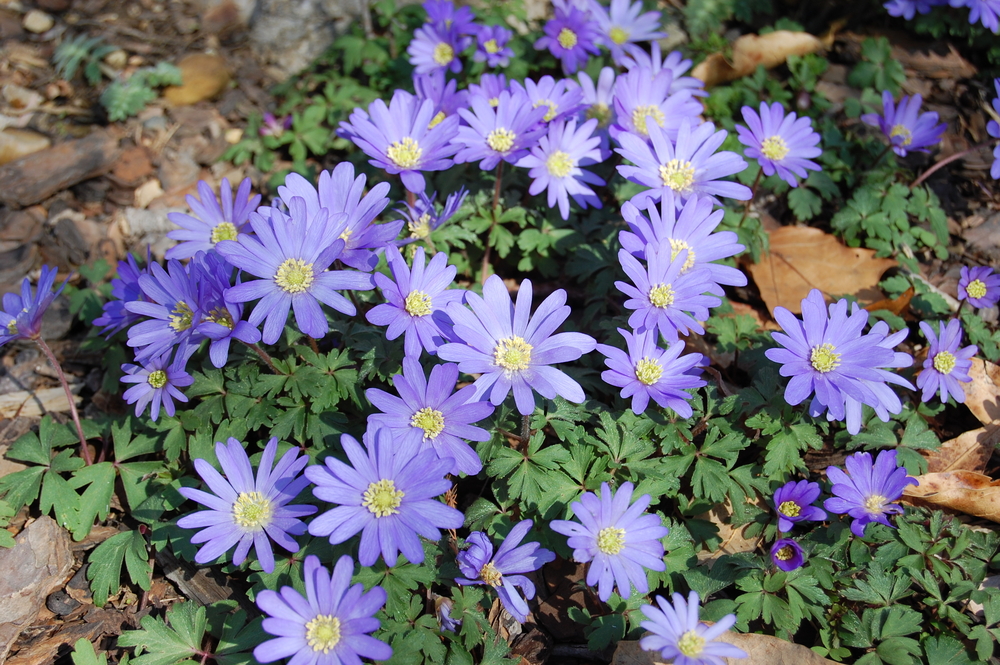
Windflower is a low growing tuberous perennial with fern like foliage. It blooms in mid-spring with charming flowers that resemble daisies in blue, white, pink, or purple.
It grows its numbers each year by self-seeding and spreading underground tubers.
For best results, soak tubers overnight before planting.
Bloom time: April
Hardiness zone: 5 to 8
Sunlight exposure: Part shade
Planting depth: Plant tubers 3 inches deep
Spacing: Plant in groups of at least 20 tubers, spaced 3 to 5 inches apart
11. Checkered Lily (Fritillaria meleagris)
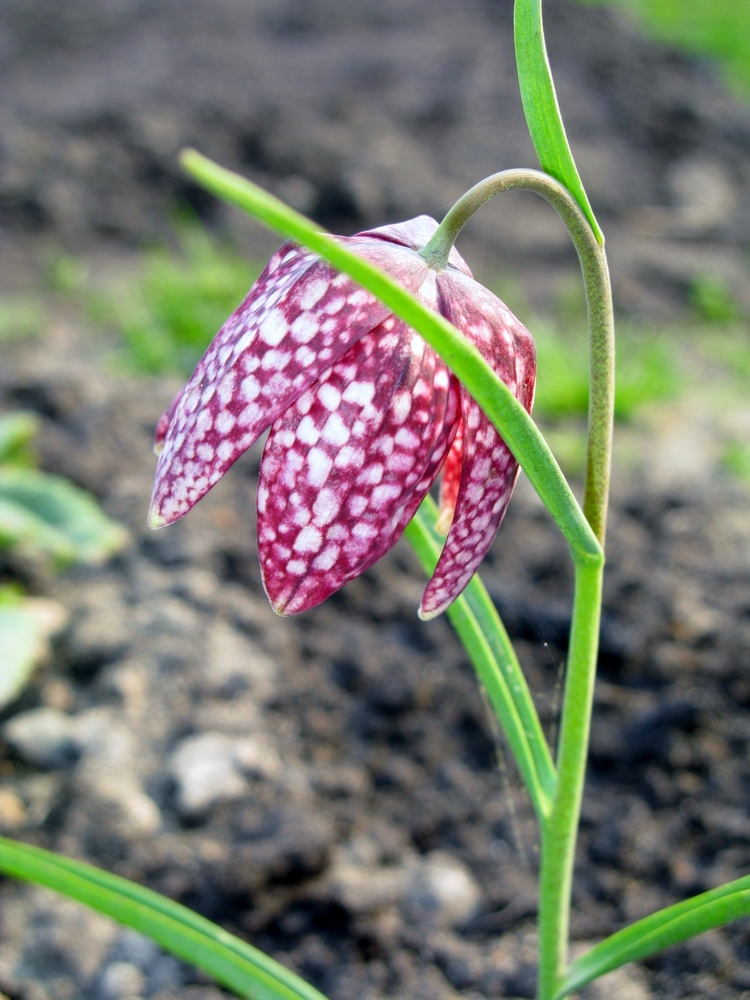
Notable for its mottled, pixelated petals, checkered lily provides a fascinating display of downward facing, bell-shaped flowers in mid-spring.
Blooms may be various shades of purple or white, veined and tinged with lighter or darker hues that give it its unusual checkerboard appearance.
Bloom time: April
Hardiness zone: 3 to 8
Sunlight exposure: Full sun to part shade
Planting depth: Plant bulbs 3 inches deep
Spacing: Plant in large groups, spaced 3 to 4 inches apart
12. Hyacinth (Hyacinthus orientalis)

Hyacinth is a popular springtime bulb that blossoms in dense spikes of small, lilac like flowers in blue, purple, pink, red, or white.
It’s also esteemed for its intense fragrance that fills the surrounding air with a rich perfume. Plant it along pathways so you can fully enjoy its aroma.
Bloom time: April
Hardiness zone: 4 to 8
Sunlight exposure: Full sun
Planting depth: Plant bulbs 4 to 6 inches deep
Spacing: Space plants 4 to 6 inches apart
13. Spanish Bluebell (Hyacinthoides hispanica)
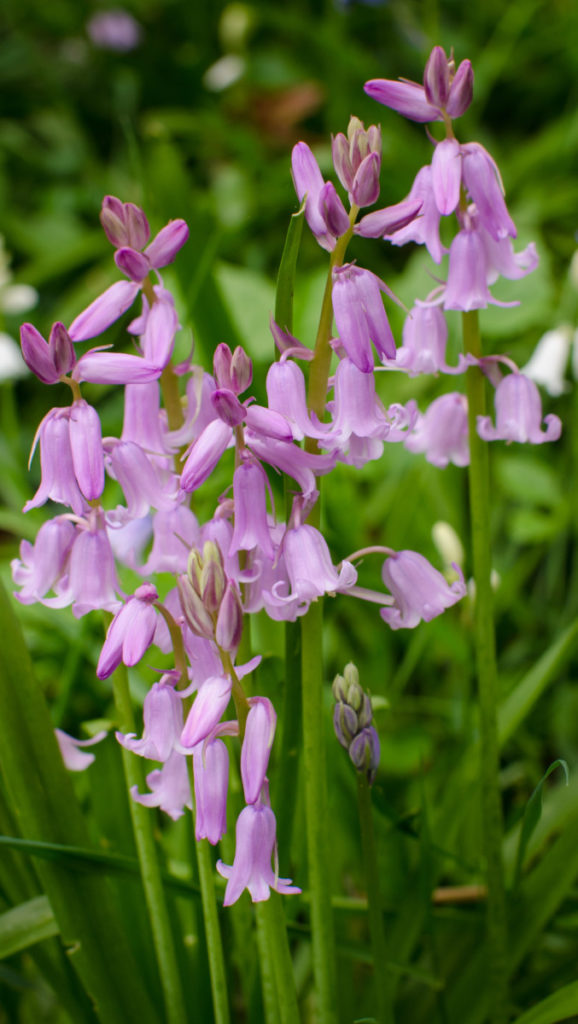
Spanish bluebell is a graceful beauty that adds color and texture to the early garden.
A clumping plant, each bulb bears 2 to 6 strappy leaves at its base, with a single upright raceme arising above the foliage. The flower stem can reach a height of about 18 inches, each containing a dozen or more nodding lavender to blue inflorescence.
It propagates easily as well, through self-seeding and bulb offsets.
Bloom time: April
Hardiness zone: 3 to 8
Sunlight exposure: Full sun to part shade
Planting depth: Plant bulbs 4 inches deep
Spacing: Space plants 4 to 6 inches apart
14. Ornamental Onion (Allium giganteum)
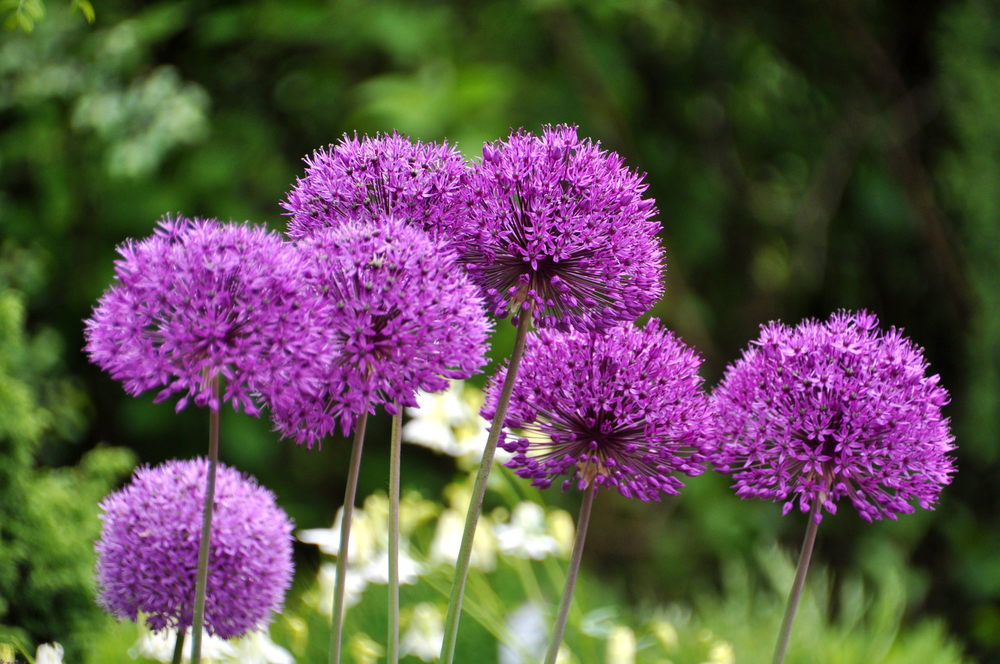
Popping up later in spring, Allium giganteum – or giant onion – grows up to five feet tall, topped with enormous blooms, about 6 inches in diameter.
The flowers are a vibrant purple, composed of numerous and tiny star-shaped florets that take the form of a dense sphere. When flowerheads are disturbed, they emit the sweet scent of onions.
Other worthy ornamental onion choices include Globemaster, Gladiator, Mont Blanc, and White Giant.
Bloom time: May
Hardiness zone: 5 to 8
Sunlight exposure: Full sun
Planting depth: Plant bulbs 6 inches deep
Spacing: Space plants 9 to 12 inches apart
15. Crown Imperial (Fritillaria imperialis)
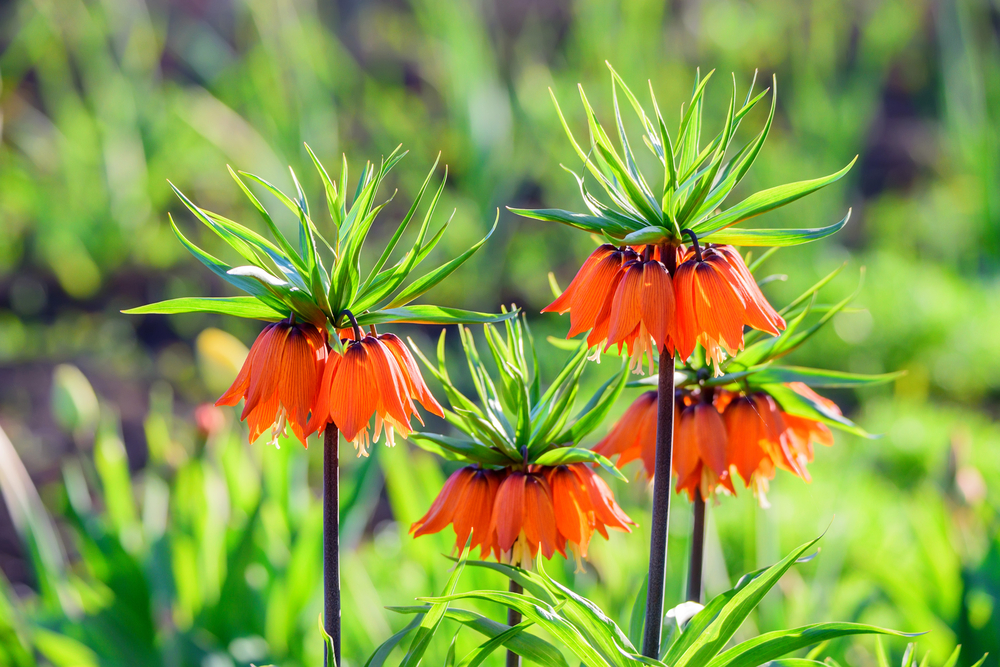
Crown imperial is a striking and unusual late spring bloomer that towers over most other plants.
Each bulb produces a single flowering stem that grows 4 feet tall. Wavy, lance shaped green leaves whorl around the lower part of the stem. It blooms with an array of downward facing, lily like flowers in orange, red, or yellow. The blooms are topped by an impressive crown of leafy bracts.
Emitting a musky odor, crown imperial’s fragrance is said to repel mice, moles, and other small critters.
Crown imperial bulbs are planted sideways in the soil to prevent bulb rot.
Bloom time: May
Hardiness zone: 5 to 8
Sunlight exposure: Full sun to part shade
Planting depth: Plant bulbs 6 inches deep
Spacing: Plant in groups of 6 to 12 bulbs, spaced 9 to 12 inches apart
Spring Bulb Planting Tips
Plant spring blooming bulbs in September or October, when temperatures are cool but before the first frost in your region. This will allow them to grow and develop a strong root system before they become dormant in winter.
Store unused bulbs in a dry, dark spot with temperatures between 50°F and 60°F.
Plant bulbs, corms, and tubers at the correct depth every time by using a hori hori knife or a bulb planting tool.
Spring bloomers look best when planted in large, irregular groups. Try tossing a handful on the ground and planting them where they land for a more natural look.
Also try to choose spots where you will be able to see them grow come spring. In view of a kitchen or living room window, or lining walkways and other high traffic areas will allow you to really appreciate the blooms.
Once bulbs are in the ground, water generously and cover with 2 to 3 inches of mulch.
Be sure to add plant markers so you don’t forget where and what you planted!

Get the famous Rural Sprout newsletter delivered to your inbox.
Join the 50,000+ gardeners who get timely gardening tutorials, tips and tasks delivered direct to their inbox.


